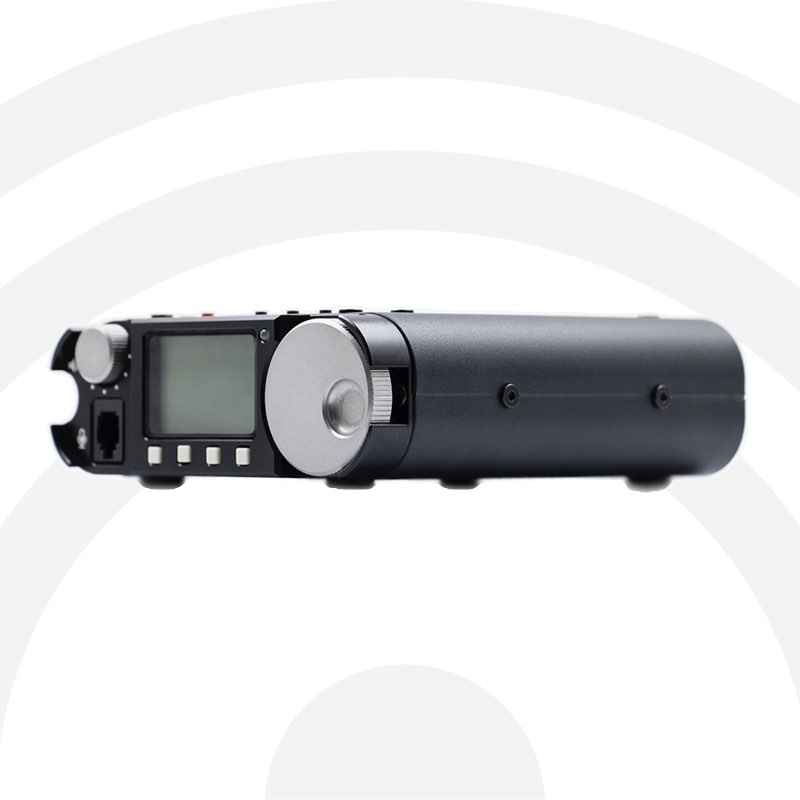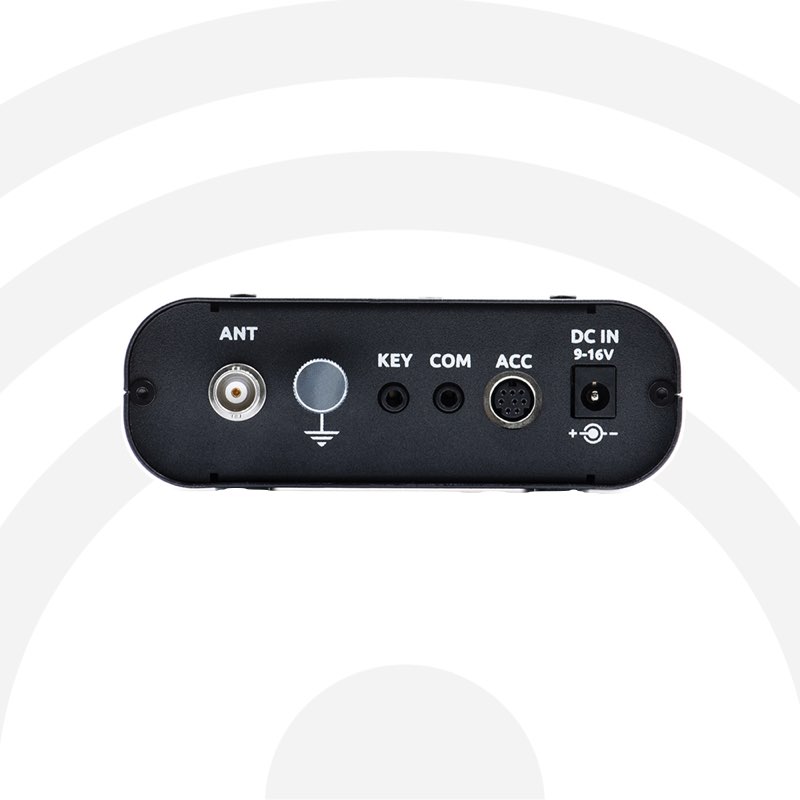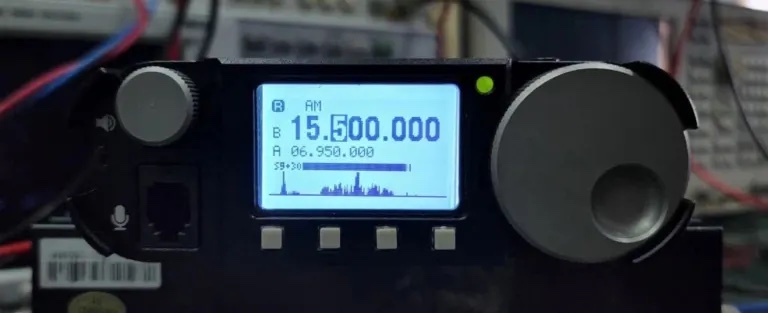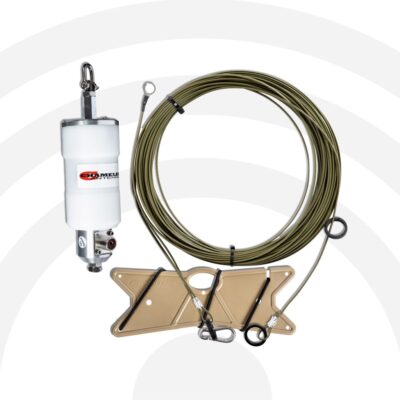Xiegu G106 HF QRP SDR Transceiver
In stock
The Xiegu G106 is a small but sturdy 80-10 meter 5W QRP transceiver with general receive in HF 0.55-30 MHz and broadcast FM 88-108 MHz.
331.09 $
In stock
Scroll down below videos for Features and Specifications!
The Xiegu G106 is a new 5 watt QRP transceiver with a general coverage receiver 0.55-30 MHz with SSB/CW/AM transmit capabilities in the 80 to 10 meter amateur radio bands, WARC bands included. The G106 also have Wide FM receive in the broadcast FM band 88-108 MHz.
The G106 is based on an SDR architecture with 16bit sampling to deliver superior performance. It has a digital CW filter with three bandwidths to help you fight interference and get more clear reception of weak signals. With the optional external DE-19 digital adapter, it can be connected to a PC for working digital modes including FT8.
As an entry-level portable SDR transceiver, G106 will be the perfect HF transceiver to start explore the bands with SSB, CW and exciting digital modes like FT8.
Xiegu G106 Features
- High-performance SDR 16-bit circuit
- Compact, robust and user friendly
- General coverage HF receiver
- Transmit in all amateur radio bands 3.8~29.7MHz
- WFM broadcast receiving in 88-108 MHz
- Digital modes option capable
- Computer control ready
Xiegu G106 General Specifications
| RX frequency range: | 0.55~30MHz | 88~108MHz (WFM) | |
| TX frequency range: | 3.5~3.9MHz
10.1~10.15MHz 18.068~18.168MHz 24.89~24.99MHz |
7.0~7.2MHz
14.0~14.35MHz 21.0~21.45MHz 28.0~29.7MHz |
|
| Operating mode: | SSB/CW/AM , WFM (receive only) | ||
| Receiving sensitivity: | CW: 0.25uV @10dB S/N
SSB: 0.5uV @10dB S/N AM: 10uV @10dB S/N |
||
| Frequency stability: | ±1.5ppm within 30min after power on
@25°C: 1ppm/hour |
||
| Transmitting power: | ≥5W @13.8V DC | ||
| Transmitting spurious suppression: | ≥50dB | ||
| Audio output power: | 0.3W | ||
| Operating voltage: | 9~15V DC | ||
| Standby current: | 0.37A @Max | ||
| Transmitting current: | 2.8A @Max | ||
| Dimensions: | 120*40*135 (mm) | ||
| Weight: | About 720g (radio unit) | ||
Xiegu G106 In the Box
-
- G106 radio unit
- Hand microphone with speaker
- 12 Volt DC power cord
- English manual
- Xiegu Warranty Card
- Xiegu Quality certificate
- Declaration of conformity
https://pileupdx.com/wp-admin/post-new.php
Xiegu G106 Suggested Accessories
-
- DE-19 USB digital modes expansion port for easy PC connection
- CE-19 Analogue expansion port for digital modes
- GY-03 External Speaker
- XPA125B 100W Solid State Linear Amplifier
- L4001 amplifier control cable for XPA125B
- Authentic FTDI USB Serial Cable for Xiegu transceivers
- BNC male to SO239 female adapter for connecting antennas with UHF connector
- 12 VDC Power Cable with 2.5mm plug
- Frequency Extension Mod, enables full HF range TX
| Dimensions | 30 × 20 × 9 cm |
|---|
Based on 4 reviews
Add a review
You must be logged in to post a review.










Gabor, HA3MGA –
I bought my G106 from Pileup on 15.05.2023. I was not satisfied with the available CAT control options in Fldigi, therefore I spent approximately a week on it and made the appropriate XML file for perfect CAT control. It was quite tricky as the manual is not accurate, the responses from the radio is not fully corresponding to the ICOM standard. After a short email exchange with the author of Fldigi (W1HKJ), he made it officially available.
The manufacturer claims the G106 works with the CAT control settings of IC-7100. It is only partially true! Only the frequency control works, but you must choose manually the required data mode on the radio (U-D or L-D).
With my RigCAT control file you can control the frequency and also the modes from Fldigi. It makes possible to utilize a trick, which will make easier to work with weak stations in PSK31, RTTY or Olivia 8/250. To be able to TX, the radio should be in data mode (U-D or L-D). However, during RX, you can utilize the CW filters of the radio. The 50 Hz filter is quite good for PSK31 and the 250 Hz filter is perfect for RTTY and Olivia 8/250. With some smart macros, you can do the VFO adjustment and the mode change with single click from Fldigi. This is the reason, why it is important to be able to control also the mode via CAT not only the VFO.
Despite of the above difficulties, I like my G106 very much and now I have full blown CAT control in Fldigi and a rock-solid CAT interface between the radio and my laptop.
You can read my instructions here: Xiegu G106 and Fldigi Setup by HA3MGA.
Hopefully the above things could help other OMs who also have the G106 radio.
73! de HA3MGA Gabor
Gabor, HA3MGA –
Jo – F5NFB –
On August 24, I contacted New Zealand from France using CW with 5W and a G5RV. My interlocutor (ZL2IFB) simply transmitted with 100W and a two-element antenna. He told me an RST of 459… Everything is said about the capabilities of this transceiver.
Jo – F5NFB –
ADRIAN RYAN –
To be honest, it’s not that I needed another transceiver, it was bought on a whim, having seen your sale price of 299 Euro.
The first step was to update the firmware to the latest version. As received, it was still using version 1.0, 22/July/2022. The latest version is revision 1.2, 20/September/2022. The Xiegu notes detailing this omit one very important step – setting the speed! The default setting of 9,600 Baud has to be changed to 115,000 Baud. Once this has been done, then the firmware update proceeds as shown in the notes. Note, there does not seem to be any method of altering the speed of the serial COM port, and furthermore, the interface is 3.3V TTL rather than standard RS-232, so you MUST use the accessory cable, not a normal USB-RS232 cable wired to a 3.5mm plug.
After that, I put it through its paces.
Power Consumption
Since this transceiver is probably intended for portable operation, it would be important to keep the power consumption low. In receive, it draws 290mA with the pre-amp off, and 330mA with the pre-amp on. For comparison, the Lab599 Discovery transceiver draws 100mA, whilst my Elecraft KX3 draws 240mA, and my Elad FDM-Duo draws 470mA.
Transmit
The power O/P in transmit depends upon the supply voltage.
On 20m, CW
14.2V 13.8V 12.6V 12.0V 11.1V 10.0V
6.5W 6.1W 5.1W 4.8W 4.0W 2.6W
1.33A 1.30A 1.25A 1.20A 1.16A 0.98A
Power Output/Band / 13.8V
10M 12M 15M 17M 20M 30M 40M 60M 80M
5.7W 7.7W 7.0W 6.0W 6.1W 4.6W 5.1W 5.6W 7.0W
In SSB, the idle power consumption with zero modulation is 650mA.
Receiver
This is not the most sensitive receiver. I measured mine, and the Minimum Detectable Signal in the SSB mode is -115dBm/0.4uV with the pre-amp on, and -97dBm/3uV with the preamp off. Whilst its sensitivity is adequate, you almost always have to have the preamplifier engaged. There is no attenuator. Whilst in the CW mode the bandwidth is adjustable from 50Hz to 500Hz, there is no equivalent adjustment for SSB, it is fixed at about 2.4kHz. One positive factor, unlike some of Xiegu’s other radios, this one is commendably free of spurious signals. Such few as there are are below atmospheric noise and can only be heard when a screened dummy load is connected, and even then, only with the preamplifier on. There are some loud tuning glitches.
This is a Type-1 SDR, (Direct Conversion), and as the spectrum display is separate, there are ‘Ghost’ signals visible. If there are any strong signals exactly +/- 12kHz from the tuning point, then they will appear twice on the display, either side. The spectrum display span is +/- 24kHz, and again, if there are strong signals exactly +/- 24kHz from the tuning point they too will be visible on both sides of the display.
There is a fair amount of local oscillator radiation in receive. The LO signal exiting from the antenna socket is -48.7dBm with the preamplifier off, and -74.2dBm with it on.
Tuning Glitches
5.305/6, 7.073/4, 7.215/6, 21.220/1
Spurii
S1 noise: 1.828
Weak spurii: 21.025, 21.504, 29.449
And Now For The Bad Points
1. The main tuning knob increments in discrete steps, and in my case often misses a step, which makes tuning and adjustments somewhat hit and miss.
2. There is no SWR meter.
3. There is no VOX capability.
4. There is no way to adjust the output power.
5. There is no headphone output other than on the microphone, and even this is only to one earpiece (Left) of a stereo headset, nor is there an external speaker jack.
6. The audio from the internal speaker is lacking in treble, and somewhat muffled.
7. Unless you are prepared to purchase the DE-19 interface box, there is almost no way for you to use a digital mode such as FT-8. If you make yourself a patch box using a 4-pin telephone connector to plug into the microphone socket as well as some way of triggering the PTT line then it would be possible, but by itself the radio is incapable of digital mode operation. The PTT line at the microphone socket is 3.3V when in receive, and when grounded supplies 400uA, thus only either an open-collector or open-drain transistor or a dry relay contact is suitable.
8. When pressing the PTT switch in SSB, there is a momentary full O/P RF power spike. This makes operation with a linear amplifier somewhat problematic, especially as the O/P power cannot be changed, other than by reducing the microphone gain for SSB. There is no adjustment for CW. The nominal 5W O/P is too much for my Lab500 linear and can only just be accommodated with my Juma PA-100D with full I/P attenuation. As there is no keyline O/P, you would have to make yourself an RF sense feed through box to derive a keyline signal to put a linear into transmit, unless you have a linear that is already so equipped. In this regard, perhaps the initial spike might be useful in initiating a transmit signal. A bug is only a bug until you find a use for it, then it becomes a feature! Nevertheless, deriving a key-line signal from the RF would involve hot-switching the linear into transmit which might be risky.
9. The AGC is always on, and there is no means to adjust its time-constant. However, its default setting seems reasonable for both SSB and CW.
10. There is no split capability.
So, what exactly do you get for 300 Euro? You get a minimal 5W SDR transceiver, with a receiver that whilst not the most sensitive is adequate, and commendably free from spurii. However, it is subject to ‘Ghost’ signals on the panadaptor. It lacks many of the common amenities of other radios, SWR meter, VOX, adjustable bandwidth, adjustable O/P power, headphone socket, etc, and without the DE-19 accessory unit is incapable of digital mode operation. The transmitter is reasonably clean but emits a full-power spike when going into transmit on SSB.
Overall, not bad considering the price, and possibly a good ‘starter’ radio without too many complexities. I suspect, though, that it would not be very long before you would be frustrated by the compromises of this radio and would want something more capable.
Adrian, 5B4AIY
ADRIAN RYAN –
ADRIAN RYAN (verified owner) –
To be honest, it’s not that I needed another transceiver, it was bought on a whim, having seen your sale price of 299 Euro.
The first step was to update the firmware to the latest version. As received, it was still using version 1.0, 22/July/2022. The latest version is revision 1.2, 20/September/2022. The Xiegu notes detailing this omit one very important step – setting the speed! The default setting of 9,600 Baud has to be changed to 115,000 Baud. Once this has been done, then the firmware update proceeds as shown in the notes. Note, there does not seem to be any method of altering the speed of the serial COM port, and furthermore, the interface is 3.3V TTL rather than standard RS-232, so you MUST use the accessory cable, not a normal USB-RS232 cable wired to a 3.5mm plug.
After that, I put it through its paces.
Power Consumption
Since this transceiver is probably intended for portable operation, it would be important to keep the power consumption low. In receive, it draws 290mA with the pre-amp off, and 330mA with the pre-amp on. For comparison, the Lab599 Discovery transceiver draws 100mA, whilst my Elecraft KX3 draws 240mA, and my Elad FDM-Duo draws 470mA.
Transmit
The power O/P in transmit depends upon the supply voltage.
On 20m, CW
14.2V 13.8V 12.6V 12.0V 11.1V 10.0V
6.5W 6.1W 5.1W 4.8W 4.0W 2.6W
1.33A 1.30A 1.25A 1.20A 1.16A 0.98A
Power Output/Band / 13.8V
10M 12M 15M 17M 20M 30M 40M 60M 80M
5.7W 7.7W 7.0W 6.0W 6.1W 4.6W 5.1W 5.6W 7.0W
In SSB, the idle power consumption with zero modulation is 650mA.
Receiver
This is not the most sensitive receiver. I measured mine, and the Minimum Detectable Signal in the SSB mode is -115dBm/0.4uV with the pre-amp on, and -97dBm/3uV with the preamp off. Whilst its sensitivity is adequate, you almost always have to have the preamplifier engaged. There is no attenuator. Whilst in the CW mode the bandwidth is adjustable from 50Hz to 500Hz, there is no equivalent adjustment for SSB, it is fixed at about 2.4kHz. One positive factor, unlike some of Xiegu’s other radios, this one is commendably free of spurious signals. Such few as there are are below atmospheric noise and can only be heard when a screened dummy load is connected, and even then, only with the preamplifier on. There are some loud tuning glitches.
This is a Type-1 SDR, (Direct Conversion), and as the spectrum display is separate, there are ‘Ghost’ signals visible. If there are any strong signals exactly +/- 12kHz from the tuning point, then they will appear twice on the display, either side. The spectrum display span is +/- 24kHz, and again, if there are strong signals exactly +/- 24kHz from the tuning point they too will be visible on both sides of the display.
There is a fair amount of local oscillator radiation in receive. The LO signal exiting from the antenna socket is -48.7dBm with the preamplifier off, and -74.2dBm with it on.
Tuning Glitches
5.305/6, 7.073/4, 7.215/6, 21.220/1
Spurii
S1 noise: 1.828
Weak spurii: 21.025, 21.504, 29.449
And Now For The Bad Points
1. The main tuning knob increments in discrete steps, and in my case often misses a step, which makes tuning and adjustments somewhat hit and miss.
2. There is no SWR meter.
3. There is no VOX capability.
4. There is no way to adjust the output power.
5. There is no headphone output other than on the microphone, and even this is only to one earpiece (Left) of a stereo headset, nor is there an external speaker jack.
6. The audio from the internal speaker is lacking in treble, and somewhat muffled.
7. Unless you are prepared to purchase the DE-19 interface box, there is almost no way for you to use a digital mode such as FT-8. If you make yourself a patch box using a 4-pin telephone connector to plug into the microphone socket as well as some way of triggering the PTT line then it would be possible, but by itself the radio is incapable of digital mode operation. The PTT line at the microphone socket is 3.3V when in receive, and when grounded supplies 400uA, thus only either an open-collector or open-drain transistor or a dry relay contact is suitable.
8. When pressing the PTT switch in SSB, there is a momentary full O/P RF power spike. This makes operation with a linear amplifier somewhat problematic, especially as the O/P power cannot be changed, other than by reducing the microphone gain for SSB. There is no adjustment for CW. The nominal 5W O/P is too much for my Lab500 linear and can only just be accommodated with my Juma PA-100D with full I/P attenuation. As there is no keyline O/P, you would have to make yourself an RF sense feed through box to derive a keyline signal to put a linear into transmit, unless you have a linear that is already so equipped. In this regard, perhaps the initial spike might be useful in initiating a transmit signal. A bug is only a bug until you find a use for it, then it becomes a feature! Nevertheless, deriving a key-line signal from the RF would involve hot-switching the linear into transmit which might be risky.
9. The AGC is always on, and there is no means to adjust its time-constant. However, its default setting seems reasonable for both SSB and CW.
10. There is no split capability.
So, what exactly do you get for 300 Euro? You get a minimal 5W SDR transceiver, with a receiver that whilst not the most sensitive is adequate, and commendably free from spurii. However, it is subject to ‘Ghost’ signals on the panadaptor. It lacks many of the common amenities of other radios, SWR meter, VOX, adjustable bandwidth, adjustable O/P power, headphone socket, etc, and without the DE-19 accessory unit is incapable of digital mode operation. The transmitter is reasonably clean but emits a full-power spike when going into transmit on SSB.
Overall, not bad considering the price, and possibly a good ‘starter’ radio without too many complexities. I suspect, though, that it would not be very long before you would be frustrated by the compromises of this radio and would want something more capable.
Adrian, 5B4AIY
ADRIAN RYAN –